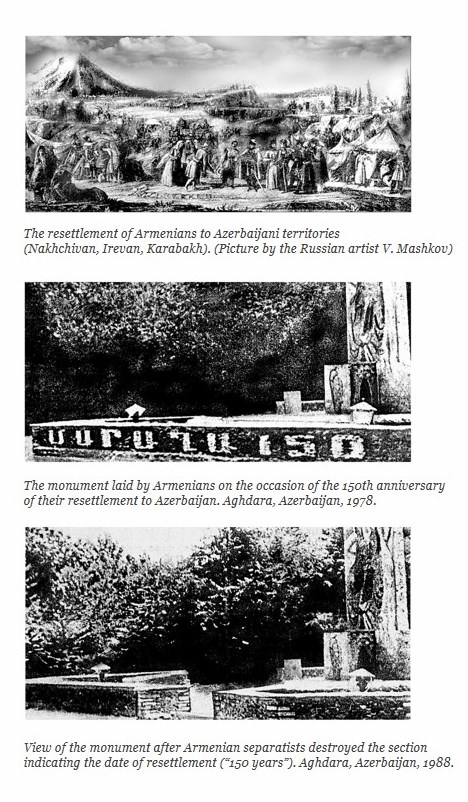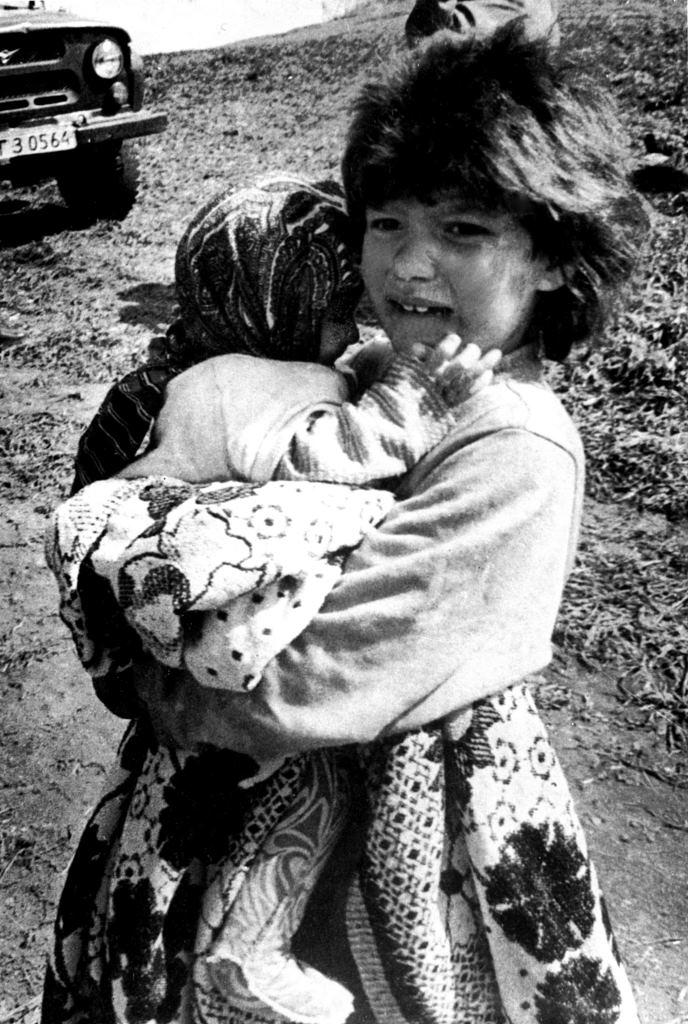After the signing of the Gulistan and Turkmenchay treaties in 1813 and 1828 respectively, there was a very rapid mass resettlement of Armenians to Azerbaijani lands and a subsequent artificial division of territory. Although the Armenian incomers constituted a small minority in the region, they soon pursued a policy of political expansion and devised aggressive plans for its implementation.
The First World War also contributed to the increase in numbers of Armenians in the South Caucasus. That process, accompanied by the imposition of artificial territorial division, laid the basis for long-term instability, tension and conflict in the area. Between 1905 and 1907, the Armenians conducted a series of large-scale bloody attacks against Azerbaijanis. The atrocities began in Baku and extended over the whole of Azerbaijan and Azerbaijani villages in the lands of present-day Armenia. Hundreds of settlements were destroyed and wiped off the face of the earth, and thousands of civilians were brutally slain.
Taking advantage of the situation created by the First World War and the February and October 1917 revolutions in Russia, the Armenians pursued their plans under the banner of Bolshevism. Thus, with the pretext of combating counter-revolutionary elements, in March 1918 the Baku commune began to implement a plan to eliminate Azerbaijanis from the whole of Baku province. Apart from Baku, and solely because of their ethnic identity, thousands of Azerbaijanis were also annihilated in the Shamakhy and Guba districts, as well as in Karabakh, Zangezur, Nakhchivan, Lenkeran and other regions of Azerbaijan. In those areas, the civilian population was exterminated en masse, villages were burned and national cultural monuments were obliterated.
Following the establishment of Soviet rule in Armenia in late 1920, the Armenians were presented with a real opportunity to fulfil their dream of extending the Armenian State into the lands of other nations. Over the 70 years of Soviet rule, they did this systematically and methodically at Azerbaijan’s expense, using every means possible to expel Azerbaijanis from their lands. Thus, in 1920, the Armenians declared Zangezur and a number of other Azerbaijani lands to be part of the Armenian Soviet Socialist Republic (SSR). Moreover, although the mountainous part of Karabakh was retained within Azerbaijan, it was nevertheless given the status of autonomy with its administrative borders defined in such a way as to ensure that the Armenian population constituted a majority. Thus, an artificial entity was created in the territory of Azerbaijan, while more than half a million Azerbaijanis living compactly in Armenia at the time were refused the same privilege.
Apart from that, during the Soviet period, purposeful efforts were taken towards changing the demographic composition of the population in Armenia. Thus, under the pretext of resettling Armenians arriving from abroad, many Azerbaijanis were forced to leave Armenia. By special decisions of the USSR Council of Ministers adopted on 23 December 1947 and 10 March 1948, more than 150,000 Azerbaijanis were forced to move to Azerbaijan from their historical homelands in Armenia in the period from 1948 to 1953.
At the end of 1987, the Armenian SSR openly laid claim to the territory of the Nagorno-Karabakh Autonomous Oblast (NKAO) of the Azerbaijan SSR. After this, there were further expulsions of Azerbaijanis from the Armenian SSR and the NKAO. A number of unlawful decisions were taken by both Armenia and the Armenian community in Nagorno-Karabakh to institute a process of unilateral secession of the region from Azerbaijan.
On 22 February 1988, near the settlement of Askeran on the Khankendi-Aghdam highway, Armenians opened fire on a peaceful Azerbaijani demonstration. Two Azerbaijani youths lost their lives as a consequence, becoming the first victims of
the conflict.
Shortly after the assertion of claims on Nagorno-Karabakh, the Armenian authorities issued instructions that resulted in about 250,000 Azerbaijanis being forcibly deported from their homes in Armenia. The process of deportation was accompanied by widespread and systematic killing, torture, destruction of property and pillaging throughout Armenia. In total, 216 Azerbaijanis were killed in Armenia during 1987-1989, including children, women and elderly people.
Long before the world witnessed the horrifying terrorist attacks that took place on 11 September 2001 and afterwards in different countries, Armenian security agencies and terrorist organizations were perpetrating terrorist acts within Azerbaijan, targeting civilian facilities, including industrial units and means of air, sea and land transportation. Such acts took the lives of over 2,000 Azerbaijanis from the late 1980s, the majority of them women, elderly and children.
Shortly after the Soviet Union ceased to exist at the end of 1991 and both Armenia and Azerbaijan were accorded international recognition, armed hostilities and Armenian attacks on Azerbaijan intensified. Armenia unleashed the war, used force against Azerbaijan and occupied its territories, including the Nagorno-Karabakh region and seven adjacent districts. Armenia conducted ethnic cleansing of the areas seized, expelling about one million Azerbaijanis from their land of origin and committed other serious crimes during the conflict. Finally, it established a subordinate, ethnically pure separatist entity in the occupied Azerbaijani territory.
The international community has consistently deplored and condemned the use of military force against Azerbaijan and the resulting occupation of its territories. In 1993, acting on behalf of all members of the United Nations, the UN Security Council adopted resolutions 822 (1993), 853(1993), 874 (1993) and 884 (1993), condemning the use of force against Azerbaijan and the occupation of its territories, while reaffirming the sovereignty and territorial integrity of Azerbaijan and the inviolability of its internationally recognized borders. In those resolutions, the UN Security Council reaffirmed that the Nagorno-Karabakh region is part of Azerbaijan and demanded the immediate, full and unconditional withdrawal of the occupying forces from all occupied territories of Azerbaijan. The UN General Assembly adopted three resolutions on the conflict (48/114 of 20 December 1993, 60/285 of 7 September 2006 and 62/243 of 14 March 2008) and included as a special item “The situation in the occupied territories of Azerbaijan” on the agenda of its regular sessions. Other international organizations have adopted similar positions.
The occupation ended on September 27, 2020 as a result of a 44-day war that began with a counter-offensive operation carried out by the glorious Azerbaijani Army under the leadership of Supreme Commander-in-Chief Ilham Aliyev. During the war, Armenian political-military leadership, as in previous years, targeted the civilian population and bombed Azerbaijani cities situated tens of kilometers away from the conflict zone. As a result, 93 people, including 12 children, were killed and more than 400 civilians were injured.


